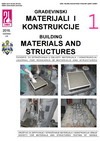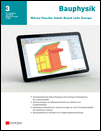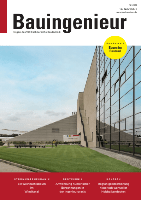
Nanotechnologies in Construction-A Scientific Internet-Journal
Scope & Guideline
Pioneering Research for a Stronger, Smarter Built Environment
Introduction
Aims and Scopes
- Nanomaterials in Construction:
Research on the incorporation of nanomaterials, such as carbon nanotubes and nanoparticles, to modify and enhance the properties of traditional construction materials like cement, concrete, and polymers. - Sustainable Construction Practices:
Exploration of sustainable methods and materials in construction, including the recycling of waste materials and the development of eco-friendly composites, which contribute to a circular economy. - Advanced Material Development:
Focus on the creation and optimization of new composite materials that offer improved performance, such as higher strength, durability, and thermal insulation, through the use of nanotechnology. - Characterization and Testing Methodologies:
Development of innovative testing methods and characterization techniques for assessing the properties and performance of nanostructured materials in construction. - Interdisciplinary Approaches:
Encouragement of interdisciplinary research that combines knowledge from materials science, engineering, and environmental studies to address complex challenges in construction.
Trending and Emerging
- Circular Economy and Waste Utilization:
An increasing number of studies focus on recycling waste materials into construction products, promoting a circular economy that reduces environmental impact and resource consumption. - Polymer and Composite Innovations:
There is a notable rise in research on polymer-based composites, particularly those enhanced with nanomaterials, which are being developed for their superior properties and applications in construction. - Nanotechnology for Enhanced Performance:
Emerging themes include the use of nanotechnology to improve the performance characteristics of construction materials, such as increasing strength, durability, and resistance to environmental factors. - Smart Construction Technologies:
The integration of smart technologies, including automation and monitoring systems that utilize nanotechnology, is gaining traction, reflecting a shift towards more intelligent construction methodologies. - Environmental and Health Safety of Nanomaterials:
There is a growing concern and focus on the environmental and health impacts of nanomaterials, leading to research aimed at ensuring safe application practices in construction.
Declining or Waning
- Traditional Construction Materials:
There has been a noticeable decline in research focused solely on traditional materials without the integration of nanotechnology, indicating a shift towards more innovative, nanomaterial-based alternatives. - Generalized Environmental Impact Studies:
Research that broadly addresses environmental impact without specific links to nanotechnology applications is becoming less prevalent, as the focus shifts to more targeted studies that evaluate nanomaterials' specific environmental benefits. - Basic Theoretical Studies:
The decline in purely theoretical studies in favor of applied research that demonstrates practical applications of nanotechnology in construction suggests a trend towards more hands-on, experimental approaches. - Non-nanotechnology Related Innovations:
Innovations that do not incorporate nanotechnology are decreasing, as the journal increasingly prioritizes research that explicitly integrates nanotechnology into construction practices.
Similar Journals

Advances in Concrete Construction
Fostering Excellence in Building EngineeringAdvances in Concrete Construction, published by TECHNO-PRESS in South Korea, is a pivotal academic journal dedicated to the fields of Building and Construction, Civil and Structural Engineering, and Mechanics of Materials. Established with the aim of fostering innovative research, this journal has rapidly gained recognition, achieving a commendable Q2 ranking across multiple categories, including Safety, Risk, Reliability, and Quality as of 2023. Featuring a blend of rigorous peer-reviewed articles, the journal serves as a vital platform for scholars, engineers, and students alike to disseminate cutting-edge research and practical applications in concrete construction technologies. Despite its absence of Open Access, the journal's inclusion in Scopus with notable rankings - such as #66 in Building and Construction - underscores its growing influence and commitment to quality as it converges on significant advancements from 2016 to 2024. By contributing to this respected journal, you join a community dedicated to exploring the future of sustainable and efficient construction practices.

Gradevnski Materijiali I Konstrukcije-Building Materials and Structures
Shaping the future of construction through open-access research.Gradevnski Materijiali I Konstrukcije - Building Materials and Structures is a premier open-access journal dedicated to advancing the field of construction materials and structural engineering. Published by SOC MATERIALS & STRUCTURES TESTING SERBIA, this journal provides a platform for researchers, professionals, and students to share their innovative findings and developments in building materials. With a commitment to open-access since 2012, it fosters unrestricted availability of research for a wider audience, encouraging collaboration and knowledge dissemination. The journal features a diverse range of topics, including material testing, structural integrity, and sustainable construction practices, making it a vital resource for those engaged in the design and analysis of structural components. By fostering the advancement of research and practice in this crucial sector, Gradevnski Materijiali I Konstrukcije plays an essential role in shaping the future of construction and material science.

Bauphysik
Innovating the Future of Architecture and ConstructionBauphysik, published by ERNST & SOHN, is a prestigious journal dedicated to the fields of architecture, building construction, and environmental engineering. With a strong focus on the principles of building physics, Bauphysik serves as a key platform for researchers, professionals, and students alike, disseminating vital information and advancements within the industry. The journal, boasting an ISSN of 0171-5445 and an E-ISSN of 1437-0980, is well-regarded with a categorization in the Q2 quartile in Architecture and Q4 quartiles in Building and Construction and Environmental Engineering as of 2023. Its Scopus ranks further highlight its impact within the community, with rankings of 83/189 in Architecture, 179/223 in Building and Construction, and 167/197 in Environmental Engineering. Despite its lack of open access options, the journal's retrospective convergence from 1982 to 2024 marks its long-standing influence in advancing building physics research. With a dedicated readership, Bauphysik encourages the exploration and sharing of innovative solutions to contemporary challenges in the built environment.

Advanced Steel Construction
Pioneering Research in Structural Engineering ExcellenceAdvanced Steel Construction is a prominent journal published by the Hong Kong Institute of Steel Construction, dedicated to the field of structural engineering and material sciences with a specific focus on steel construction techniques and advancements. Since its inception in 2005, the journal has established itself as a valuable resource for researchers, professionals, and students alike, offering insights into the latest developments and innovative practices within the realms of building construction, civil engineering, and materials mechanics. With its recognition as a Q2 journal across multiple engineering categories, including Building and Construction, Civil and Structural Engineering, Mechanical Engineering, and Mechanics of Materials, it ranks competitively in Scopus rankings, highlighting its significance in academic discourse. The journal is based in China, at the Hong Kong Polytechnic University, and provides an essential platform for sharing groundbreaking research and fostering collaboration within the engineering community.

MATERIALS AND STRUCTURES
Exploring the Intersection of Materials and StructuresMATERIALS AND STRUCTURES, published by SPRINGER, is a prestigious peer-reviewed journal dedicated to advancing the fields of building and construction, civil and structural engineering, and materials science. With an impressive impact factor and a notable Q1 ranking across multiple categories in the 2023 Journal Citation Reports, including Mechanics of Materials, this journal stands as a vital resource for researchers and professionals seeking to disseminate and access high-quality research. Established in 1985, it has continually evolved, showcasing revolutionary research and emerging technologies in material engineering. The journal provides a platform for innovative ideas and methodologies, contributing significantly to the body of knowledge essential for the advancement of sustainable construction practices. Although it does not currently offer Open Access options, the rigorous peer review process ensures the integrity and relevance of its publications, cementing its role as a leading journal in its field. Researchers, industry experts, and students alike will find invaluable insights within its pages, making MATERIALS AND STRUCTURES an essential read for anyone involved in engineering and materials research.

Revista Ingenieria de Construccion
Exploring the Intersection of Theory and Practice in ConstructionRevista Ingenieria de Construccion is a prominent open-access journal dedicated to advancing knowledge and practice in the fields of building and construction engineering, as well as civil and structural engineering. Published by the Pontificia Universidad Católica de Chile, specifically the Department of Engineering and Construction Management, this journal has been providing free access to quality research outputs since 1986, ensuring that vital information is available to both practitioners and academics globally. With its current placement in the Q4 category of both the Building and Construction and Civil and Structural Engineering quartiles, it serves as a platform for innovative studies and critical discussions, positioning itself strategically within the academic landscape. The journal is indexed in Scopus, ranking #157 in Building and Construction and #291 in Civil and Structural Engineering, reflecting the growing impact and relevance of its contributions. Researchers, professionals, and students are encouraged to engage with the rigorous and diverse content published within its pages, fostering a vibrant academic and practical discourse.

Revista de la Construccion
Advancing Civil Engineering Knowledge for a Sustainable FutureRevista de la Construcción is a pivotal academic journal dedicated to the field of civil engineering and construction, published by the prestigious Pontificia Universidad Católica de Chile, Escuela de Construcción Civil. With its ISSN 0718-915X, this journal serves as a crucial platform for disseminating innovative research, case studies, and advancements in construction methodologies that address contemporary challenges within the industry. While currently not classified as open access, it provides valuable insights benefiting researchers, professionals, and students engaged in construction development and sustainability. The journal enhances the academic discourse and contributes significantly to knowledge in engineering practices, project management, and material science. Based in Santiago, Chile, the journal aims to foster collaboration and knowledge exchange among experts both locally and globally, making it an essential resource for those striving to advance the science and practice of construction.

Bauingenieur
Pioneering Research for a Sustainable Built EnvironmentBauingenieur, an established journal in the field of Building and Construction and Civil and Structural Engineering, has been a significant platform for scholarly discourse since its inception in 1969. Published by VDI FACHMEDIEN GMBH & CO KG UNTERNEHMEN FACHINFORMATIONEN in Germany, this journal, available in both print (ISSN: 0005-6650) and electronic formats (E-ISSN: 1436-4867), serves as a vital resource for researchers, professionals, and students dedicated to advancing knowledge and practice in engineering. Although currently without open access options, Bauingenieur aspires to contribute to the academic community by presenting cutting-edge research, case studies, and technical reviews within the realms of construction and civil engineering. As evidenced by its categorizations in the 2023 Scopus rankings, where it has a Q4 designation in both relevant categories, it provides an essential resource for understanding current trends and challenges in the industry. The journal welcomes contributions that push the boundaries of knowledge and foster innovative solutions in the built environment.

Magazine of Civil Engineering
Exploring New Frontiers in Construction and EngineeringMagazine of Civil Engineering, published by ST-PETERSBURG STATE POLYTECHNICAL UNIVERSITY, is a prominent open access journal dedicated to the field of civil and structural engineering. With an ISSN of 2712-8172 and E-ISSN 2071-0305, it serves as a vital platform for disseminating high-quality research, innovative methodologies, and current trends in building and construction. Since its inception in 2010, the journal has embraced open access, ensuring broad visibility and accessibility for its contributions to the academic community. The magazine holds a respectable position in the academic hierarchy, ranked in the Q3 quartile for both Building and Construction and Civil and Structural Engineering categories as of 2023. It is indexed in Scopus, amplifying its societal impact and reach with a rank of #114/223 in Building and Construction and #224/379 in Civil and Structural Engineering. Researchers, professionals, and students alike are encouraged to engage with the cutting-edge studies presented in the magazine, contributing to the advancement of knowledge and practice within the civil engineering domain.

R Journal
Advancing the Frontiers of Statistical ComputingR Journal, published by the R Foundation for Statistical Computing, is a premier academic journal dedicated to advancing the fields of numerical analysis and statistical methodologies. With an ISSN of 2073-4859, the journal has established itself as a significant platform for high-quality research since its inception in 2009. It operates under a Q2 category ranking in respective fields, including Statistics and Probability, among others, highlighting its influence and relevance in the academic community. Researchers are encouraged to contribute their findings, as the journal appeals broadly to statisticians, mathematicians, and data scientists alike. Although not an open-access journal, its commitment to rigorous peer review ensures that published works maintain high standards of scientific integrity. The R Journal's vision is to foster innovative approaches within statistical computing, making it an invaluable resource for those seeking to deepen their understanding or stay abreast of developments in the discipline.